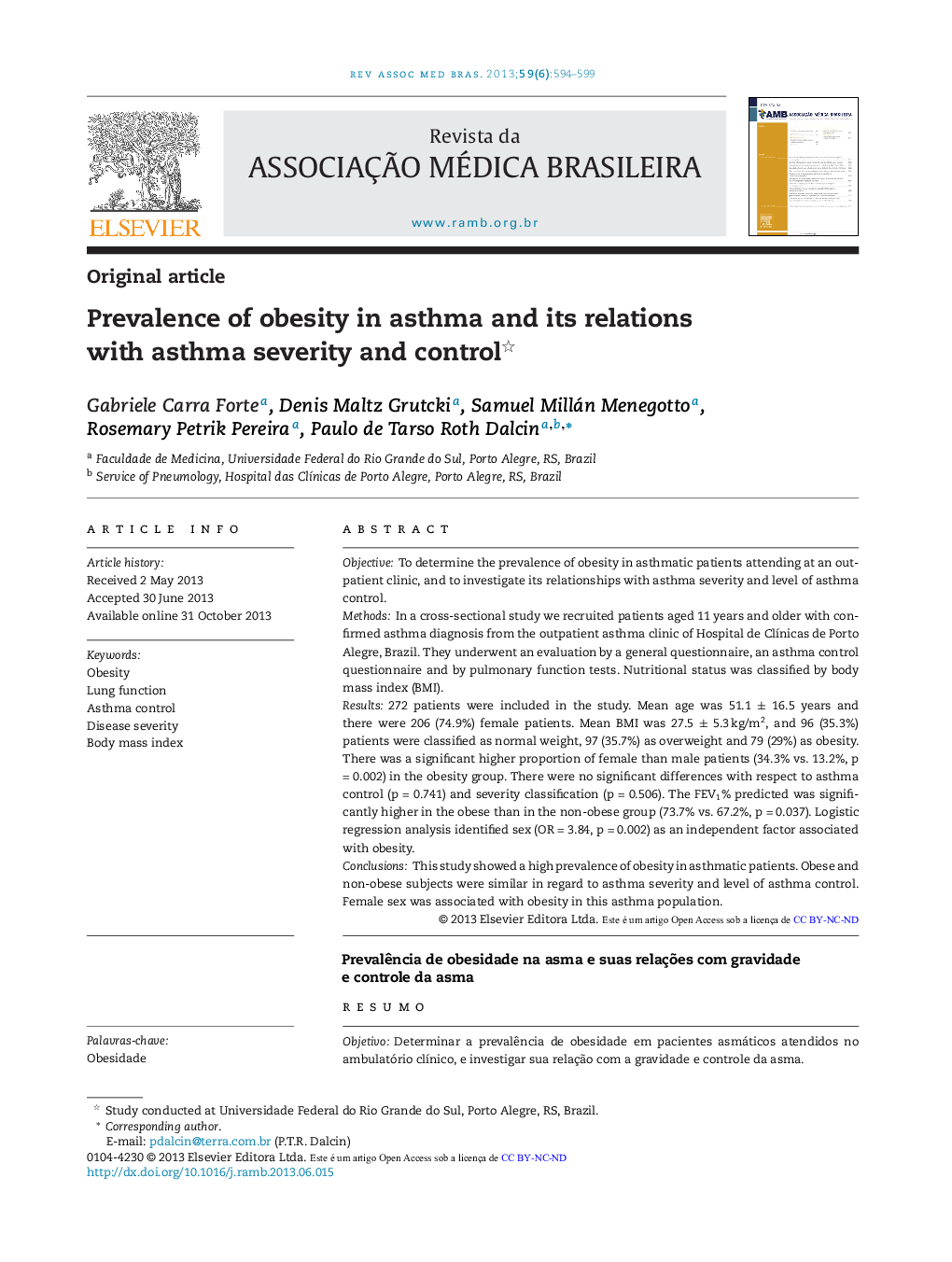| Article ID | Journal | Published Year | Pages | File Type |
|---|---|---|---|---|
| 3824994 | Revista da Associação Médica Brasileira | 2013 | 6 Pages |
ObjectiveTo determine the prevalence of obesity in asthmatic patients attending at an outpatient clinic, and to investigate its relationships with asthma severity and level of asthma control.MethodsIn a cross-sectional study we recruited patients aged 11 years and older with confirmed asthma diagnosis from the outpatient asthma clinic of Hospital de Clínicas de Porto Alegre, Brazil. They underwent an evaluation by a general questionnaire, an asthma control questionnaire and by pulmonary function tests. Nutritional status was classified by body mass index (BMI).Results272 patients were included in the study. Mean age was 51.1 ± 16.5 years and there were 206 (74.9%) female patients. Mean BMI was 27.5 ± 5.3 kg/m2, and 96 (35.3%) patients were classified as normal weight, 97 (35.7%) as overweight and 79 (29%) as obesity. There was a significant higher proportion of female than male patients (34.3% vs. 13.2%, p = 0.002) in the obesity group. There were no significant differences with respect to asthma control (p = 0.741) and severity classification (p = 0.506). The FEV1% predicted was significantly higher in the obese than in the non-obese group (73.7% vs. 67.2%, p = 0.037). Logistic regression analysis identified sex (OR = 3.84, p = 0.002) as an independent factor associated with obesity.ConclusionsThis study showed a high prevalence of obesity in asthmatic patients. Obese and non-obese subjects were similar in regard to asthma severity and level of asthma control. Female sex was associated with obesity in this asthma population.
ResumoObjetivoDeterminar a prevalência de obesidade em pacientes asmáticos atendidos no ambulatório clínico, e investigar sua relação com a gravidade e controle da asma.MétodosEstudo transversal, envolvendo pacientes, com idade igual ou superior a 11 anos e diagnóstico de asma confirmado, do ambulatório clínico do Hospital de Clínicas de Porto Alegre, Brasil. Os pacientes foram submetidos à avaliação através de um questionário geral, questionário de controle da asma e teste de função pulmonar. O estado nutricional foi classificado conforme o índice de massa corporal (IMC).ResultadosForam incluídos no estudo 272 pacientes, sendo 206 (74,9%) pacientes do sexo feminino. A média de idade foi 51.1 ± 16.5 anos. O IMC médio foi 27.5 ± 5.3 kg/m2, sendo 96 (35.3%) pacientes classificados como eutróficos, 97 (35,7%) como sobrepeso e 79 (29%) como obesidade. Observou-se significativamente maior proporção de pacientes do sexo feminino no grupo de obesidade quando comparados aos pacientes do sexo masculino (34.3% vs. 13.2%, p = 0.002). Não houve diferença significativa em relação ao controle da asma (p = 0.741) e classificação de gravidade (p = 0.506). O FEV1% predito foi significativamente maior nos pacientes obesos quando comparados aos não obesos (73.7% vs. 67.2%, p = 0.037). A análise de regressão logística identificou gênero como fator independente associado com a obesidade. (OR = 3.84, p = 0.002).ConclusãoO presente estudo observou alta prevalência de obesidade em pacientes asmáticos. Indivíduos obesos e não obesos tiveram similaridade para gravidade e controle da asma. O gênero feminino foi associado com obesidade nesta população asmática.
